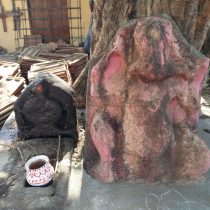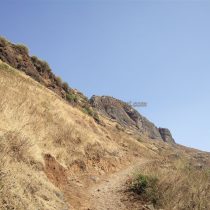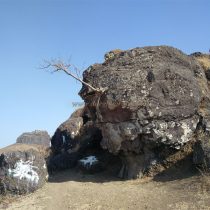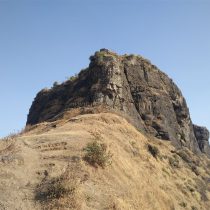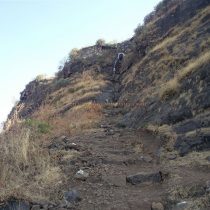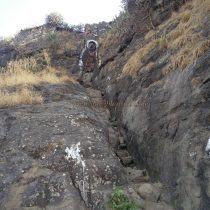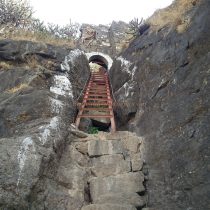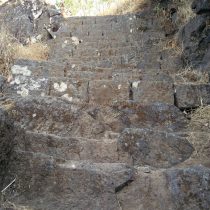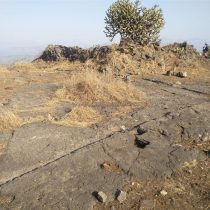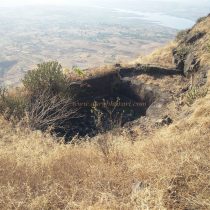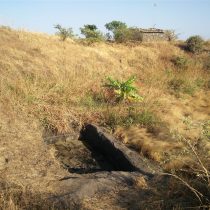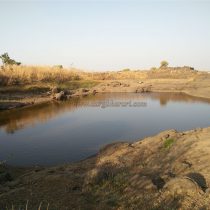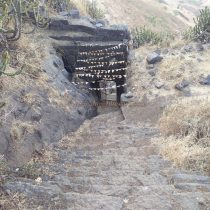KAVNAI
TYPE : HILL FORT
DISTRICT : NASHIK
HEIGHT : 2920 FEET
GRADE : MEDIUM
Kapildhara is still famous as the original place of Sinhastha Kumbh Mela but Kavnai fort, which is a short distance from this place, is still unknown to tourists. The fort can be visited in just one day from Mumbai, Pune, and Nashik. On the Mumbai-Nashik highway, while traveling from Mumbai, after crossing about 4 km from Ghoti near Khambale village, on the left side is the Kavnai fork. After traveling 3 km from this fork, there is a road on the right from Waki. At the beginning of the road, there is an arch inscribed as Kavnai fort and Kavnai village at the base of the fort is at a distance of 4 km from here. This distance is 45 km from Nashik city &17 km from Igatpuri. The Kapildhara shrine has been developed due to Sinhastha Kumbh Mela and the road from Waki to Kavnai has been made paved.
...
Kapildhara Ashram is located before the village and Kavnai village is 1 km away from this Ashram. Since Kavnai village is at a height, some of our paths are crossed by vehicle. Upon entering the village, you can see the fort on the right-hand side. There is a temple of Lord Mahadev and Hanuman in the village and there is a magnificent idol of Bajrangbali in the Hanuman temple. The village has two small mansions and some idols and carved stone remains around the temples. On the right side of the village, one can see the trunk of the Kavnai fort descending into the village. This is the only way to reach the fort. An overhead water tank at the beginning of the road is a mark to remember this path. A path leads to the cistern in front of the Hanuman Temple. At the beginning of the path, you see a Samadhi with a tomb. After proceeding further on this trunk, a small pinnacle is formed at the end of the trunk. At the top of this pinnacle, you can see the ramparts of the fort and the saffron fluttering on it. From here, the path turns left and turns right again and leads directly to the gate of the fort through a gorge. When you come to the gorge, you can see the door on the top of it. The carved steps of the gorge as well as the stone remains lying here indicate that there is another door on the lower side of the gorge. The steps on the lower side of the gorge are still standing and the steps on the upper side have been worn out and an iron ladder has been installed in that place. Climbing this ladder, you enter the fort through the north-facing gate. Even though it is on the cliff, this door is still standing firm. There are two bastions at some distance on either side of the door and there is a small cave on the right side after entering the door. The cave has a small excavated cistern filled with stones and occasionally 4-5 people can easily stay in this cave. Above the doorway are 25-30 steep steps, and on the left side of the bastion is a small cistern filled with soil. As you climb the steps through the door, you enter the fort. It takes an hour and a half to reach here from the foothills. At an altitude of 2370 feet above sea level, the fort has a triangular head and is spread over an area of 6 acres from south to north. Once you reach the top of the fort, start exploring the fort from the left side. At the beginning of this path, the first thing you see are the remains of some houses and walls. From the top bastion, you can see a hill shaped like Kothligad in front of you. On the right side of the road is a large lake full of water. On the left side of the lake, there is a structure without a roof and in front of this structure, there is a Shivling and Nandi in the open on a quadrangle structure. There is a small temple of Goddess Kavnai (Kamakshi) on the bank of the lake. The temple has two idols, one of them is old and the other one is new and is made out of marble. There are two bastions at the back of the temple. This bastion is in the direction of Kapildhara shrine and from this bastion, the entire area of Kapildhara shrine can be seen. Near the bastion, a partially carved cistern and a rainwater harvesting cistern can be seen. The ramparts of the bastions in this area are still standing. On this bastion are some of the steps carved in the rock. On the right-hand side of the road and at the back of the temple, there is a dry rainwater harvesting lake and on one side of this lake, there is a rock carved cistern. The water from this cistern is used for drinking on the fort. At the same place, on the left side of the road on the slope of the valley, you can see a large cistern carved in the rock. Moving ahead from here, we reach the bastion on the upper side of the trunk. After seeing this and reaching the hill near the temple you will see the remains of a mansion. A little further along the same path, to the right, are the remains of another mansion. A flagpole is visible on this hill. From this hill, the Kalsubai mountain range is visible to the south, while Bhaskargad, Harihar, Trimbakkagad, and Tringalwadi are visible to the north. Anjaneri is also visible to the north. This path leads to the main entrance through which you entered the fort and your fort round is completed here. There are not many ruins to see on the fort so, you can explore the entire fort in about an hour. Although it is not known exactly when the Kavnai fort was built, its proximity to Kavnai village suggests that the fort has existed since ancient times. Kapildhara near Kavnai fort is the origin of Sinhastha Kumbh Mela. After the division of this Kumbh Mela by the Peshwas, the fair of Shiv worshipers started to be held at Trimbakeshwar and the fair of Ram worshipers started to be held at Nashik. Even today, Sinhastha Kumbh Mela is held at Kapildhara. It is said that during the Ram-Ravan war, when Lakshman was attacked by a force, he fell unconscious, and to bring him back to his senses Hanuman came to this shrine to fetch Sanjivani Buti. While coming to this shrine Hanuman fought with the demon Kavnai and ended his life, the village is named after this demon. The Ram temple at Kapildhara has a plate-like Chinese bell given by a Chinese traveler named Hu-en-Tsang. About one thousand five hundred years ago that is in around 629 to 645, he visited India. In 640, second Pulakesh Chalukya and Huentsang met each other in Nashik. Huen Tsang gave two bells while visiting Kavnai. One of the bells is in the Archaeological Museum in Delhi. When Huentsang came to Nashik, Kumbh Mela must have started in Nashik because he has mentioned that he saw many monks. Shri Kamakshi Mata Mandir is located near Kapildhara Tirtha at the foot of Kavnai. This temple also has mythological significance in Ramayan. This fort, which was in nijamshahi was conquered by the Mughals around 1635-36 AD. After this, around 1670-72, the fort was conquered by the Marathas during Shivaji Maharaj’s period. Later Around 1688, the fort was recaptured by the Mughals. There is no record of when this fort came to the Marathas after this but it is mentioned in a letter of Chimaji Appa. The ancient temple of Kamakshi was renovated by the Peshwas between 1750 and 1765 and it is mentioned in the Peshwa Daftar that the Peshwas offered gold and silver ornaments to Goddess Kamakshi. These ornaments are still available at the temple and are offered to the Goddess during Navratri and Chaitra Purnima. Kavnai was formerly a taluka but in 1861 the British moved it to Igatpuri.
© Suresh Nimbalkar

